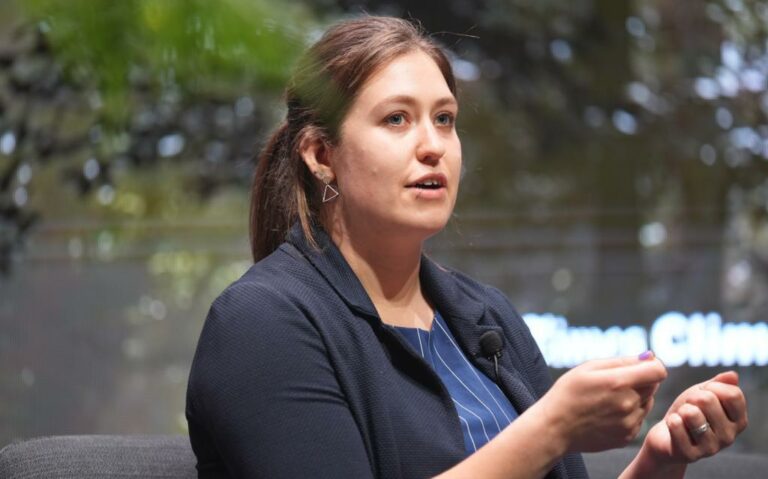By Rachel Nixseaman
Rachel from Scotland is a passionate youth and community worker with YMCA Bellshill and Mossend. As a facilitator, Rachel supported the delivery of Scotland’s Climate Assembly and has delivered learning events for local climate action networks, bringing together local businesses, charities and residents to work towards positive climate action.
 I was invited to join the Bright Lights: Scottish Youth Climate Initiatives panel at the New York Times Climate Hub, sharing my thoughts and experiences of youth engagement and co-design processes, and was joined by members of the Young People’s Forest Project, as well as children from the Children’s Parliament who took part in Scotland’s Climate Assembly. Both of these projects offer unique opportunities for children and young people to influence and shape climate action in Scotland.
I was invited to join the Bright Lights: Scottish Youth Climate Initiatives panel at the New York Times Climate Hub, sharing my thoughts and experiences of youth engagement and co-design processes, and was joined by members of the Young People’s Forest Project, as well as children from the Children’s Parliament who took part in Scotland’s Climate Assembly. Both of these projects offer unique opportunities for children and young people to influence and shape climate action in Scotland.
The Young People’s Forest is currently in the early stages of developing an accessible and inclusive piece of land to be utilised by Scotland’s young people. The Children’s Parliament supported Scotland’s Climate Assembly, bringing together children and adults of all backgrounds to create recommendations for our government to work towards positive climate action and achieve our net zero goals.
I was excited to hear from Nelly, Josh and Finn about their work with the Young People’s Forest so far. They are working alongside national youth organisations and the Forestry Commission, leading on all aspects of the project, from buying the land to planning sustainable planting. And I loved hearing from Margaret, Atholl and Seamus about their experiences with Scotland’s Climate Assembly and the impact the climate crisis is having on their homes in the Western Isles. I supported Scotland’s Climate Assembly as a facilitator, so it was interesting to hear their perspectives on the process and how their engagement differed from my own.
 I was also able to share my own experiences facilitating citizen’s assemblies, including the Climate Assembly, as well as other pieces of co-design work. While my experiences with co-design have been positive and resulted in meaningful change, everyone on the panel agreed that these opportunities are not accessible enough for children and young people, and that there is still need for radical and systemic change. Children and young people in communities across Scotland (and beyond) are passionate and engaged, delivering innovative projects to tackle issues including the global climate crisis. It is Governments and decision makers who need to make changes, creating spaces for young people’s voices to be heard, and ensuring those voices are listened to in a way that is both meaningful and genuine. These exercises should not be a tick box.
I was also able to share my own experiences facilitating citizen’s assemblies, including the Climate Assembly, as well as other pieces of co-design work. While my experiences with co-design have been positive and resulted in meaningful change, everyone on the panel agreed that these opportunities are not accessible enough for children and young people, and that there is still need for radical and systemic change. Children and young people in communities across Scotland (and beyond) are passionate and engaged, delivering innovative projects to tackle issues including the global climate crisis. It is Governments and decision makers who need to make changes, creating spaces for young people’s voices to be heard, and ensuring those voices are listened to in a way that is both meaningful and genuine. These exercises should not be a tick box.
The panel unanimously agreed that co-design processes can be a bit scary: children and young people may feel nervous sharing their ideas with decision-makers, while decision-makers are often reluctant to hand over any control to children and young people. What was evident from this panel and the examples shared, is that we need to trust the process. Co-design brings people together to share creative and innovative ideas in a safe space, working together towards positive futures.
 I loved being able to share some of my passion for youth engagement, and to be surrounded by people who share that passion also – as well as a lot of trees (they built a forest inside!) I hope that anyone who watched the panel took away some tips on how to deliver co-design processes, and will feel more confident handing control over to young people.
I loved being able to share some of my passion for youth engagement, and to be surrounded by people who share that passion also – as well as a lot of trees (they built a forest inside!) I hope that anyone who watched the panel took away some tips on how to deliver co-design processes, and will feel more confident handing control over to young people.
You can watch Rachel on the Bright Lights: Scottish Youth Climate Initiatives panel here.


